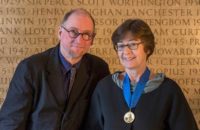
The premiere architecture award in the UK—trumping even the annual Stirling Prize for best building—is the Royal Gold Medal, the annual award for individual long-term excellence that has existed since 1848. It is presented by the Royal Institute of British Architects (RIBA) with the approval of the monarch, and counts everyone from Le Corbusier and Louis Kahn to Richard Rogers and Archigram among its recipients. Each year a new name is chiseled into the stone-lined foyer of RIBA’s London headquarters—as will be, in early 2015, the names of Dublin-based pair Sheila O’Donnell and John Tuomey.
What does winning the medal mean to you?
O’Donnell: We were totally surprised. When Stephen Hodder (RIBA president) phoned us, I was completely gobsmacked. I hadn’t seen this in the ether at all. But I was honored and delighted, because the Royal Gold Medal has a position in one’s mind as a remarkably significant thing. The names on the wall . . .
Tuomey: We’ve had hundreds and hundreds of letters, cards, and e-mails from people in all corners of the world. They seem to think that it says something about the recognition of architects of our kind. The medal has got a ranking in the world, it feels like it has credibility, integrity.
You made a conscious decision to return to Dublin in uncertain economic times, rather than continue to work for others in London. Did you have a clear goal?
Tuomey: We certainly did. It was the early 1980s. Had we stayed in London, we would have been creatively engaged and usefully employed. I would have been made an associate in Stirling’s office. But I thought, now is the time to go. We had a sense of mission, to put some meaning into unformed Irish architecture. We were worried that the architecture we’d grown up with in Ireland had lost its European character and scale.
O’Donnell: John came back in 1980; I did in 1981. At the time, it seemed an unpromising environment in which to make architecture. We were part of a movement in London in the late 1970s and early 1980s. The history of the European city was starting to impact architecture. But people were using history as shorthand, as motif. Perhaps part of coming back was a return to essentials—not what history looked like, but what it meant, how architecture grows out of context and culture.
How important is Stirling to you today?
O’Donnell: There’s the sense of his tenacity, of hanging onto an idea, but also his work method and the culture of his office. We made huge 1:50 drawings, gradually building up the layers on a key drawing that showed everything. We took that with us when we set up our own practice. We decided that was the way to make things.
Tuomey: Stirling’s office model underpins our practice. He was involved in every single aspect. We see ourselves as being like that:
I should know every railing on every half-landing. You can hold the whole scheme in your hand or head.
You are known for small- to medium-scale projects. Do you hanker after a megaproject?
Tuomey: Absolutely. We haven’t yet had that reach, but that’s not our choice. We would like to think about things on a larger scale.
We don’t want to feel confined or defined by what we have done.
O’Donnell: A piece of city, yes. But also single buildings that are larger than the often complex single buildings we’ve already done! There’s as much work and detail in them as there is in a building five times the size. And housing: wouldn’t it be great to do the equivalent of a Georgian square?
So what will be your next significant project?
O'Donnell: We’re designing the Central European University in Budapest, in a World Heritage site. It’s an international English-language postgraduate university. It has something of the feeling of an American university, of the kind where we’ve done a lot of teaching. It’s a mixture of re-use and new buildings. Big, compared to the scale of Georgian Dublin.


